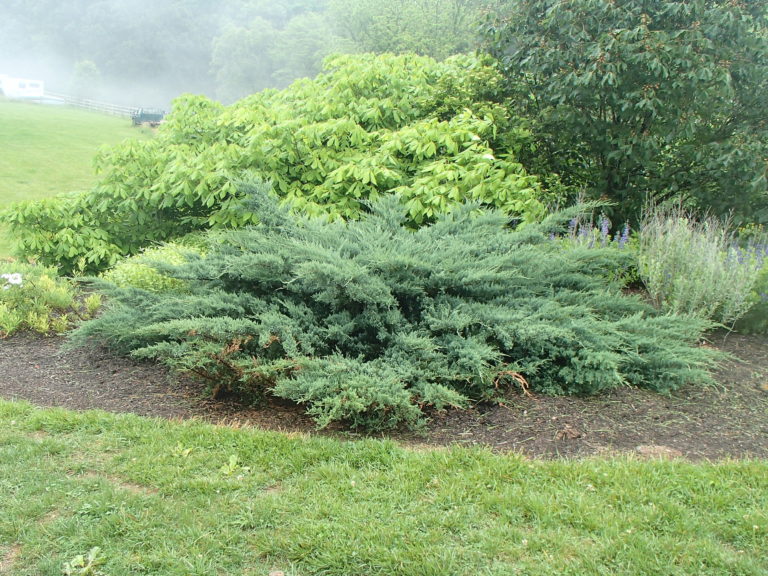Juniperus virginiana is a tough, widely distributed native evergreen tree with many outstanding attributes (see our listing for the species) and ‘Poyo’ is a dwarf, spreading cultivar which displays most of the attributes of the species, but answering a need for a shrub-like form. Since it is asexually propagated (is a clone), it’s shape is predictable — one attribute in which it differs from the species! Wider than it is tall, growth is largely horizontal with the same luxuriously dense foliage as the species, in a bright blue-green. An individual will grow to 3′ high x 4′ wide with a full center and gracefully arching branches. ‘Poyo’ is a clone of a female selection, so it displays the blue, waxy-fleshy and berrylike seed cones, sweet-tasting to birds, and resinous, ripening in September – October. ‘Poyo’ thrives in full sun and average to dry soil, on a sunny slope or as a foundation plant, wherever you want a beautiful and wildlife-friendly, short evergreen. Ours are from Sunlight Gardens in Tennessee. A “Plant of Promise’ at the Cullowhee Native Plant Conference along about 2005. Since selections do not have a natural plant distribution, the USDA distribution map linked below is for the species.
NURSERY HOURS
Wednesday: 10-4 Thursday: 10-6 Friday-Saturday: 10-4 Sunday: 12-4
Juniperus virginiana ‘Poyo’

Key Info
Scientific Name: Juniperus virginiana L. cv. 'Poyo'
Common Names: Poyo Red Cedar
Family Names: Cupressaceae (Cypress Family)
Plant Type: Tree / Shrub
Light Requirement: Full sun
Leaf Retention: Evergreen
Flower Color: Blue berries
Additional Info
Habit: Growth is markedly horizontal in this Red Cedar clone. Foliage is of fine to medium texture and thick, so that the exfoliating silvery to reddish-brown bark is largely hidden. The root system is woody, shallow, and spreading and well suited for holding soil on a slope.
Height: 3'
Spread: 4'
Soil Conditions: Mesic to dry (not wet); circumneutral pH; nutrient-poor, sandy, rockyk sandy loam, clay loam, clay, limestone-based.
Leaves: Leaves are of two types; opposite, sharp, needlelike juvenile leaves (on young plants) or opposite, simple, green or blue-green, scale-like, overlapping, closely appressed adult leaves. The juvenile leaves are found on young plants up to 3 years old, and as scattered shoots on adult trees. Fragrant, scale-like foliage is gray-green to blue-green to light- or dark-green. All colors tend to brown in winter.
Flowers (or reproductive structures: Poyo' is a clone of a female selection of Red Cedar, and its flowers or seed cones would be similar to those of female trees of the species and would be fertilized with the wind-blown pollen of nearby male trees of the species. See our listing for J. virginiana.
Fruit: Each seed cone typically contains 1-2 yellow-brown, ridged seeds about 1/8" long.
Natural Distribution: is a clone of Juniperus virginiana
USDA Hardiness Zone: 2 to 9
USDA Wetland Indicator Status in NC: FACU
Pollination: Wind
Wildlife Connections: Red Cedar is a larval host for the Olive butterfly and the Juniper Hairstreak butterfly as well as larvae of many moths, flies, beetles, scales, midges and thrips. Red Cedar's blue berry-like cones, high in carbohydrates and fats, provide excellent food for a long list of song birds and upland game birds. (The Cedar Waxwing is actually named after the tree). Because of its dense foliage, a number of bird species nest in Red Cedar (Cooper's Hawk, Blue Jay, Mockingbirds, Robins, Warblers, Finches, Sparrows) and also roost there (notably owls and sparrows). Mammals which also enjoy the sweet berries include Black Bear, Gray Fox, Opossum, Eastern Chipmunk, and White-Footed Mouse. Illinoiswildflowers.info is a great resource for these connections.
Propagation: From cuttings
